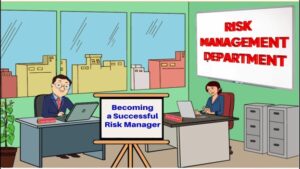…the risk manager
“Being honest may not get you a lot of friends, but it’ll always get you the right ones”

Dear Readers, this week, we shall move on to another role within the banking industry, which is very complex and yet very reliable if the role is well appreciated…..THE RISK MANAGER. Let us examine the role of risk managers in financial institutions. We will also identify the characteristics of a successful risk manager as one that embodies the principles that make risk management an essential element of organizational success.
I have looked at how successful persons have been noted to take calculated or smart risks to propel their businesses to different levels. Some of these businesses failed but the top person learned from the past mistakes and moved on again to excel next time.
On the other hand, risk managers are often seen as the gatekeepers to decisions and often associated with the word “No.” Over the years the focus of most risk managers has been on the process – identification, analysis and mitigation. Currently, many financial institutions employ a state of the art technology, using advanced analytical techniques, to quantify and scientifically measure the various risks highlighted and to alert management on best strategies to adopt to avert potential losses. While this process-oriented focus is important to successful risk management, there are also some essential characteristics of the risk managers that make their work more proactive and in sync with the goals of the institution.
The Complex Role of Risk Managers
An effective risk manager must understand his or her role in the bank and how important it is. I usually compare the role of a risk manager to a consultant. What is the bank’s objective? What are its goals? What are its people made up of? How sustainable are its goals and objectives? In some global markets, the risk manager is very powerful and his or her decisions carry a lot of weight even at the board levels. A highly effective risk manager makes decisions taking into consideration, the consequences of those decisions. Apart from the numerous cases of chief executives being fired during bank failures or crises, the risk managers are also not left alone. Where there are state interventions and forensic audits, the questions asked by the legislators include, “Didn’t the risk manager not see the signs on the wall? Did they alert management? What did they do about it? Did they not know they are caretakers of the bank?
Transferor of Knowledge
As a result of researching, scenario analysis and awareness level of risk managers, it is their duty to be teachers and transfer relevant knowledge of the subject to all staff in the bank. The knowledge shared is protective, preventative, devotional, and all other benefits there are that makes a group have a sense of belongingness. The risk manager who works closely with the identified “Risk Champions” in the various units and departments will find him or herself working as a team with a united purpose and there are little knowledge gaps.
Being Independent – “Don’t be a yes man”
Even though risk managers should flow with the tide, there is definitely a limit. Being afraid to assert one’s self in critical times makes the risk manager impotent. If every person in the bank is preaching the same message, some type of checks and balances is needed to ensure the success of the bank. This is the job of a risk manager, to be the independent assessor of problem areas within the bank. Teamwork and collaboration is good but when the danger signals are showing, they must be honest and explain their opinion in a professional way without being labelled “AGAINST”.
The Change Maker
Risk managers are gradually moving away from their traditional role to become change makers. Risk managers should be part of the movers and shakers in a bank that wants to move forward. Sometimes they are isolated and sent information of new projects for their input only at the last minute. This does not augur well for the institution and can create personal conflicts between the risk manager and the product development Teasm when there are delays in the launch of new products.
Adaptability
There is no “one-size fits all” solution to establishing a risk management process. The risk manager should be able to adapt processes, structures, decisions, and even his or her own behavior to the organizational culture. This means creating a balance between ensuring compliance and adapting to the realities on the ground in the industry. I believe in not just “cutting and pasting” processes adopted from other institutions in the industry, but in addition, customizing, massaging and aligning new processes to suit the business environment. Let us take a look at the dynamism of retail banking in Ghana. Some branches of the same bank are located in very remote countries while others are in the high class section of the capital…which is of late, the “Airport City” of Accra. This is out of the way of the average Ghanaian. Although risk management has its generic systems, managing risk in these two contrasting branches require some adaptability to make it work. The risk appetite for the various risks are usually the same but for some areas, additional zooming and study of the local conditions are required to make to make the application of some monitoring tools realistic.
A Good Communicator
A successful risk manager should exhibit good communication skills and use simple language for easy assimilation by all stakeholders. Processes need to be ‘idiot-proof”, broken down into simple terms and basic enough for new entrants to appreciate and reduce errors.
Integrity
Many bank staff get disappointed when persons who know the “ins and outs” of banking fall fowl of the banking rules and deliberately show unethical conducts. The first question asked is “Ahh, but shouldn’t he/she know better?” Banking is a human institution with its accompanying human errors. However a risk manager must practice what he or she preaches or writes about.
A recent survey conducted by Active Risk Inc. indicates that “… While the traditional view of risk managers is that they are overly pessimistic, analytical, logical, and focused solely on facts and data, a growing trend of risk managers possessing skills outside this stereotypical set suggest a new appreciation for the strength and value of risk management within an organization. No longer are risk managers buried within an organization and rarely made part of strategic-decision making”.
The risk manager usually plays a role in building a bridge to other functional and business areas within and outside of the bank. It is only the risk manager who can demand and have access to documentation from all functionaries in the bank, whether for pre-audit or post-audit. The lens of the risk manager can capture several potential hot spots in the bank. The function should not be restricted to a form filling exercise or just analyzing data. Risk managers are horizontal integrators within the bank and develop a bridge across all departments to look at the global picture. In fact, the risk person actually connects all the dots, especially the “outliers” that others do not appreciate.
Rolling up Sleeves
A risk manager must understand and analyze interdependencies across the bank. He or she must provide insights into relationships that unit, product, or project managers may not recognize due to their singular emphasis. The risk manager must stay neutral and avoid any biases. The overall picture of the bank should enable risk managers have access to sensitive data to enable them have a third eye which must be used responsibly in providing new insights and learning to the organization. This role requires a risk manager to roll up his or her sleeves and become involved in multiple areas of a program to ensure that the project groups not only know what risk management involves but also actively participate in the process.
The above shows that the role of risk managers in banking is quite complex and therefore not a place for beginners. Their neutral role means that apart from reporting to the CEO, the Chief Risk Officer (CRO) has a direct reporting role to the Board. I hope that these revelations will make you appreciate the risk managers in your institution.
I will pause for now. Next week, I will explore another complex role in the bank.
To be continued
ABOUT THE AUTHOR
Alberta Quarcoopome is a Fellow of the Institute of Bankers, and CEO of ALKAN Business Consult Ltd. She is the Author of Three books: “The 21st Century Bank Teller: A Strategic Partner” and “My Front Desk Experience: A Young Banker’s Story” and “The Modern Branch Manager’s Companion”. She uses her experience and practical case studies, training young bankers in operational risk management, sales, customer service, banking operations and fraud.
CONTACT
Website www.alkanbiz.com
Email:alberta@alkanbiz.com or [email protected]
Tel: +233-0244333051/+233-0244611343










